Differentiation of blood spatter from paintball substance by appearance on crime scene photographs
Differentiation of blood spatter from paintball substance by appearance on crime scene photographs
-
Descriptive qualitative analysis, in the absence of tools for the quantitative analysis at this time
-

Selected Articles - The News And Times
-Red's a primary colour, and is seen everywhere, so why don't you see more red paintball fill?
The obvious answer is that it resembles (to varying degrees) that other red liquid, blood. In the end, commercial paintball largely frowns upon this comparison, and subsequently red paintball fill is somewhat of a black sheep in the paintball industry.
In fitting with a milsim play style, paintball fill that looks like blood does evoke a certain sense of authenticity to any elimination. A goggle lens soaked in gooey red liquid conjures a visceral reaction from the wearer, while adding to the realism of the game.
The three large drawbacks to red fill lie in:
- The inability to distinguish between real blood and paintball fill.
- The public image drawn from paintballers using fill that looks like blood.
- It stains like crazy.
A mixture of blood and paint.
The obvious reason for the indistinguishability between blood and paint being a problem is that you can't tell when you're bleeding or seriously injured. In looking at the picture above, you might not realize that the hit is actually bleeding.
In addition, some players may overreact to being hit if the paint looks like blood. A story related to me on a forum went as follows: A player was hit on his goggle lens during a local BYOP game with a red paintball, and was unable to see out of his left eye. Thinking that he was hit through the lens and there was blood everywhere, he screamed and whipped off his mask, and was left vulnerable to potentially dangerous paintball hits. As a result of this incident, red paintballs were subsequently banned from this establishment.
Eh? What was that?
By using paintballs that look like blood, anti-paintball media is given easy cannon fodder. It only feeds uninformed and uninterested pundits that feel that paintball is some kind of juvenile hyper-realistic ultraviolence. This isn't written with the intent of banning red fill or scaring people against using it. But if you do use it, for your sake and the sake of paintball as a whole, be smart about it.A special thanks goes out to Jake, thanks for all your help!
Taken from the October 2019 issue of Physics World.
Analysing the blood stains following a shooting can be key to finding the perpetrator, but it’s a field of forensics that is being called into question. Sidney Perkowitz explains how understanding the physics behind the blood distribution could help uncover the truth
Joe Bryan, once a popular and respected high-school principal in a small Texas town, has been in prison for over 30 years. He is serving a 99-year sentence for the shooting and murder of his wife in 1985. The evidence incriminating him involved spots of the victim’s blood found on a hand-held torch. A witness, who was rated as expert in the forensic technique of blood pattern analysis (BPA), interpreted these spots as placing Bryan near his wife when she was shot – a testimony that was at the forefront of Bryan’s conviction. It overrode countervailing evidence that he was in fact at a conference 120 miles away – an alibi that made it nearly impossible for him to have shot his wife, as he would have had to leave the event, travel home, commit murder and return to the conference within a specific timeframe. Bryan maintains his innocence to this day.
Evidence like this, based on the physical behaviour of the blood generated at a crime scene, has roots in late 19th-century Europe. It became prominent in the US during the famous Sam Sheppard murder trial in 1955, and has played an important role in other murder trials since – including those of football player and actor O J Simpson (1994–1995, verdict of not guilty) and music producer Phil Spector (2007–2009, retrial verdict of guilty).
Police investigators use BPA to work backwards from blood traces at a crime scene, allowing them to reconstruct the locations and actions of the people and weapons involved. The traces include drips, smears and spatters, which are created when drops of blood radiate from the impact of a bullet or blunt instrument until they encounter a surface and stain it. But according to a startling 2009 report from the US National Academy of Sciences (NAS) that still resonates today, BPA lacks scientific rigour and valid accreditation for its practitioners. This is a serious concern because BPA results have convicted people later shown to be innocent, as many believe Bryan to be; and because lack of confidence in BPA analysis may allow the guilty to go free. As a result, it has become essential to re-assess the physics behind BPA.
Although the US leads the world in gun ownership – there are 120 guns per 100 people, and 64% of US homicides are gun-related – other countries have many shootings too. For instance, 30% of homicides in Canada involve guns, while a dozen nations, including Brazil, exceed the US in their rate of gun deaths per 100,000 people. Establishing the scientific validity of BPA could therefore have an international impact on dealing with the world’s 250,000 annual gun-related deaths by helping to categorize them as homicides or suicides – and, in the former case, potentially bringing the perpetrators to justice.
Bloody behaviour
In terms of physics, BPA reconstruction is a complicated problem in fluid mechanics that involves tracing the behaviour of blood, under various forces and ambient conditions. The challenge is made more difficult because blood is a complex fluid containing both liquid (the plasma) and solid (the blood cells) components. Furthermore, the properties of blood – such as its pH or the number of red blood cells – vary from person to person.
But this work is more than just an academic exercise. It can also have real effects, according to Alicia Carriquiry at Iowa State University in the US. As a statistician and director of the Center for Statistics and Applications in Forensic Evidence (CSAFE) – which is funded by the US National Institute of Standards and Technology (NIST) – Carriquiry has a broad view of forensic science. “BPA is one of those areas in which science has a lot to say,” she says. “As opposed to other forensic disciplines, in BPA we actually have physical and fluid-dynamical models that can help answer questions such as those having to do with trajectory, point of origin and similar.”
Fundamental science has, however, not been well applied to BPA, according to the 2009 NAS report, which was entitled Strengthening Forensic Science in the United States. Co-chaired by a distinguished US federal judge and an academic statistician, it included contributors from relevant scientific disciplines including physics. In general, except for DNA analysis, the report found deficiencies in virtually every forensic technique – including the analysis of hair, fibres, fingerprints and bite marks. “The interpretation of forensic evidence is not always based on scientific studies to determine its validity,” it stated. “This is a serious problem.” A separate report in 2016 from the US president’s Council of Advisors on Science and Technology – written by the director of the Office of Science and Technology Policy together with a panel of scientists – echoed this critique.
For BPA in particular, the NAS report noted the complexities of fluid dynamics and indicated that BPA analysts should understand the physics involved. But with no strict educational requirements for certification as a BPA expert – they’re trained only to follow packaged procedures – the report concluded that “The opinions of bloodstain pattern analysts are more subjective than scientific…The uncertainties associated with [BPA] are enormous.” In 2018 the Texas Forensic Science Commission reached similar conclusions about the Bryan case, calling the interpretation of the BPA evidence “inaccurate” and “scientifically unsupportable”.
Still, properly used, BPA can give valuable clues towards understanding the circumstances of a shooting. For example, drops of blood that strike the floor at an angle will create a set of elliptical stains, whose width-to-length ratio gives the impact angle (figure 1). BPA analysts are trained to draw straight-line trajectories that follow the long dimension of each ellipse at that impact angle. These paths converge, providing a position from which the blood originated. While this correctly gives the projection onto the floor of the location of a gunshot wound, the straight-line procedure overestimates the height of the wound, since the true paths under gravity are parabolas modified by aerodynamic drag. The error is typically large enough to wrongly place a victim as standing rather than sitting.
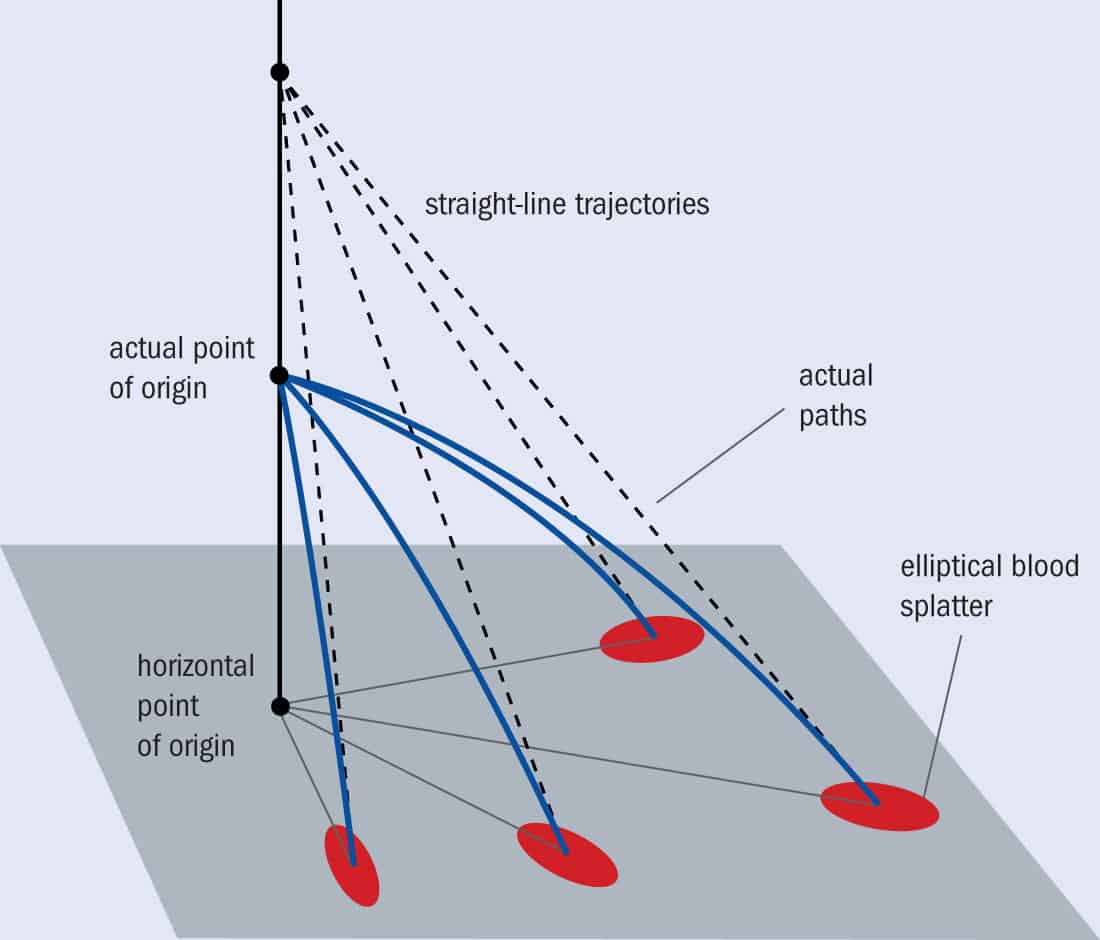 When drops of blood hit the floor at an angle, they produce elliptical stains, where their width-to-length ratio gives that impact angle. Traditionally practitioners of blood-pattern analysis trace a straight-line from the stain at the impact angle to reveal where the blood originated. While this correctly maps the paths along the floor (grey lines), straight-line trajectories (dashed lines) overestimate the vertical height of the impact because the blood would have taken a modified parabolic path (blue) due to gravity and drag.
When drops of blood hit the floor at an angle, they produce elliptical stains, where their width-to-length ratio gives that impact angle. Traditionally practitioners of blood-pattern analysis trace a straight-line from the stain at the impact angle to reveal where the blood originated. While this correctly maps the paths along the floor (grey lines), straight-line trajectories (dashed lines) overestimate the vertical height of the impact because the blood would have taken a modified parabolic path (blue) due to gravity and drag.
This is one of the established BPA methods that deeper physical analysis can improve. In 2011 physicists Christopher Varney and Fred Gittes at Washington State University put the projectile-motion equations, including gravity and drag, into a form that uses all the data inherent in a set of spatter bloodstains (Am. J. Phys. 79 838). They found that a plot of the impact angles for the stains versus the inverse of their horizontal distances from the vertical axis of impact gives a valid result for the height, provided that the launch angles for the drops are not too widely distributed. In a test that spattered a viscous blood substitute, the researchers used this approach to calculate the actual launch height of 88 cm to within 8%. For comparison, the linear trajectories overestimated the launch height by 100%.
In 2015 Nick Laan, of the University of Amsterdam and the Netherlands Forensics Institute, and colleagues instead used the fluid qualities of blood to find the height of a gunshot wound (Scientific Reports 5 11461). Earlier work had derived an equation relating the impact velocity of a liquid drop of blood to its volume and impact angle, and to the width of the dried stain it produced as determined by the known capillary and viscous behaviour of blood. To apply this method, the researchers created spatter patterns of human blood under controlled conditions. For each of 40 separate blood stains, they determined its width and impact angle, and, using a commercial 3D surface scanner, measured the volume of the stain, from which they found the volume of the original drop. These parameters yielded the impact velocity, giving enough information to solve the equations of motion under gravity with aerodynamic drag. The results for the height where each drop originated had an average value of 58.5 cm, only 8% below the true height of 63.7 cm. Meanwhile, the straight-line method gave 91.1 cm – a much larger 42% error.
A bullet’s journey
These two papers and others analyse the behaviour of blood drops after they have been formed, to enhance standard BPA. But mechanical engineers and fluid dynamicists Alexander Yarin and Patrick Comiskey from the University of Illinois at Chicago, together with Daniel Attinger at Iowa State, have gone further. They have modelled the entire process from the bullet entering the body to the final blood stain pattern.
Since 2016 these researchers have developed fluid dynamical theories for gunshot back spatter and forward spatter, where blood drops travel respectively against and with the direction of the bullet and display different characteristics. The back-spatter analysis – carried out for both regular (Phys. Rev. Fluids 1 043201) and blunt-nosed (Phys. Rev. Fluids 2 073906) bullets – is based on the well-known Rayleigh–Taylor instability. In this effect, acceleration perpendicular to the interface between two fluids of different densities – here, blood and air – creates growing turbulence and mixing between the fluids. (One remarkable example of the instability is the spectacular filaments seen in the expanding Crab Nebula, where the two fluids comprise material ejected by the Crab’s initial supernova explosion, and a plasma of relativistic charged particles powered by the Crab’s central pulsar.) Meanwhile, forward spatter, caused when the bullet exits a body after multiple disruptive encounters with blood and tissue, was treated differently. Its analysis used percolation theory, which describes available paths through randomly arranged clusters.
For both kinds of spatter, the researchers calculated the numbers, sizes and dynamical properties of the drops of blood generated by a bullet; then determined their trajectories under gravity and aerodynamic drag. Finally, the team found the number of resulting stains, their areas, impact angles and distribution with respect to distance (figure 2).
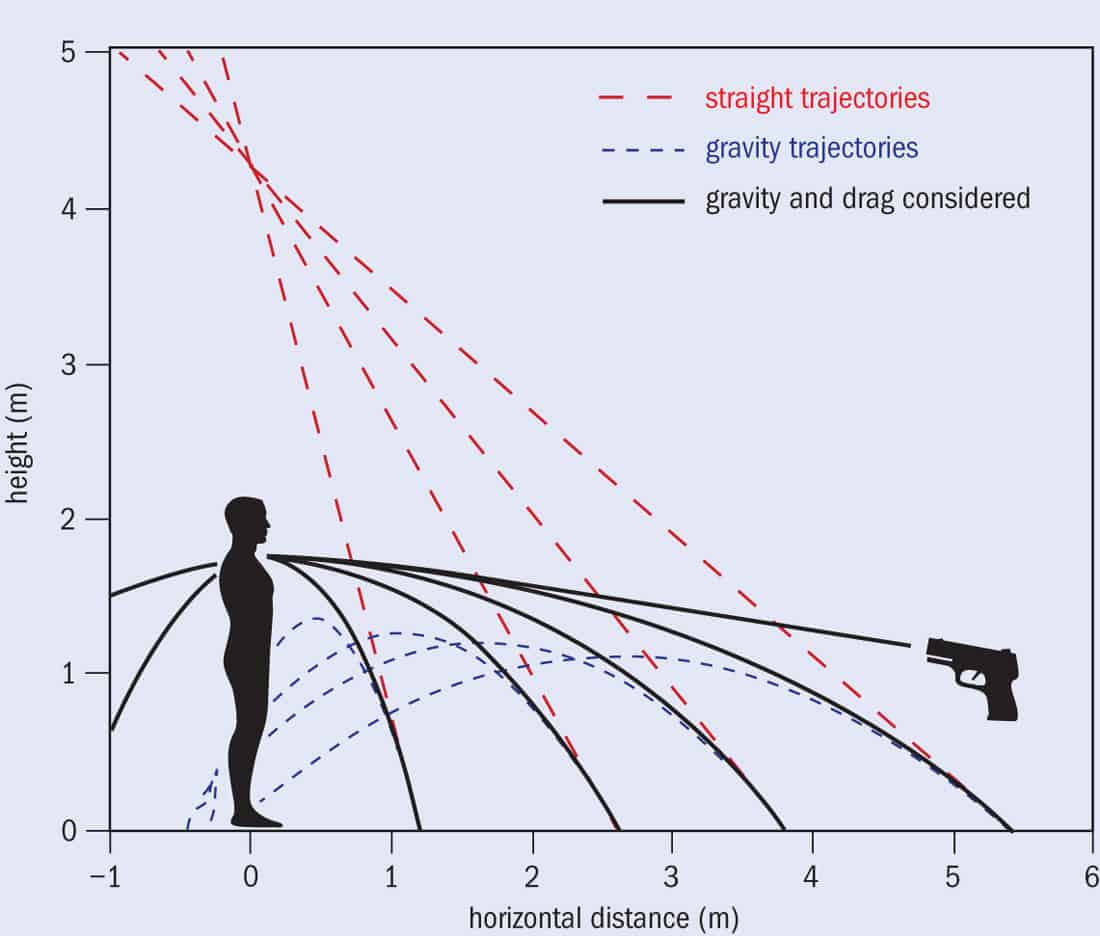 This diagram demonstrates three possible trajectories that could be mapped from back-spatter blood stains depending on what phenomena are taken into account. Straight-line paths (red), which do not account for gravity and drag, overestimate the height of impact. When drag is not considered (blue) the paths fall short. BPA needs to take into account both gravity and drag (black) to get a more accurate estimate of where the bullet impacted.
This diagram demonstrates three possible trajectories that could be mapped from back-spatter blood stains depending on what phenomena are taken into account. Straight-line paths (red), which do not account for gravity and drag, overestimate the height of impact. When drag is not considered (blue) the paths fall short. BPA needs to take into account both gravity and drag (black) to get a more accurate estimate of where the bullet impacted.
These calculated results for the blood-spatter distributions agree reasonably well with data obtained by shooting bullets into sponges or plastic foam soaked with swine blood for back spatter, and through a blood-filled reservoir for forward spatter. Although the researchers note that more experiments are needed, their results are significant steps toward a real, physics-based theory of spattering. Their work also points to new directions for study, such as how air is carried along with drops of blood in flight, which influences their trajectories, and the impact of temperature on blood viscosity.
The theoretical results so far show the value of the fluid dynamics approach but also that its complexity can add uncertainties to the analysis, for example through the variable properties of blood and blood stains. Besides temperature, the viscosity of blood also depends on the percentage of red blood cells, which varies by individual and could affect approaches like that used by Laan and colleagues. What’s more, the properties of the surface that a blood drop strikes may modify how it spreads and therefore affect the stain it leaves. Confounding elements like these should be taken into account for fully valid BPA that carries weight in court, and may limit claims about what BPA can definitively show. Certainly, there is much left to do.
From lab to crime scene
As the science of BPA progresses, a parallel challenge is to convert its results into new, practical and transparent procedures for murder investigations and courtroom presentations. But BPA practitioners have not entirely welcomed these changes, which threaten to upset established field procedures, a reaction also found elsewhere in the forensics establishment. Nevertheless, says Carriquiry, for many topics in forensic science “we have managed to make important inroads and established some meaningful partnerships with forensic practitioners who see our work as a means to make theirs more objective and ‘scientific’ ”. These partners include the Houston Forensic Science Center and the Los Angeles Police Department.
Now, with support from CSAFE and other US federal agencies, researchers are working specifically to strengthen connections between the BPA and fluid dynamics communities, and to provide practitioners with useful results. For example, Attinger and co-authors have written a tutorial paper in which they discuss the forces at play in fluid dynamics and how they determine the behaviour of blood drops at a crime scene (Forensic Science International 231 375). Attinger has also published charts based on fluid dynamics that make it simple for investigators in the field to estimate the maximum distance that a blood drop has travelled (Forensic Science International 298 97).
 (Courtesy: Data in Brief 22 269. Reused by permission of Elsevier)
(Courtesy: Data in Brief 22 269. Reused by permission of Elsevier)An example of blood back spatter on a card target, produced by researchers at Iowa State University using the set-up shown in figure 4. The bullet hole can be seen in the top left of the middle image.
In another effort, Attinger’s team has published back-spatter patterns of human blood produced in the lab by gunshot (figure 3), with rigorous control of the firearms and ammunition used and the physical arrangement (Data in Brief 22 269); and a second set of blood patterns produced by blunt instruments (Data in Brief 18 648). These provide high-resolution images of blood stains generated under varied conditions, for training and research use (figure 4). In one project, Hal Stern at the University of California–Irvine, a statistician and co-director of CSAFE, is examining the images for distinctive features that practitioners could use to distinguish among possible sources for observed spatters. In other outreach, BPA researchers also present talks and training sessions at professional societies.
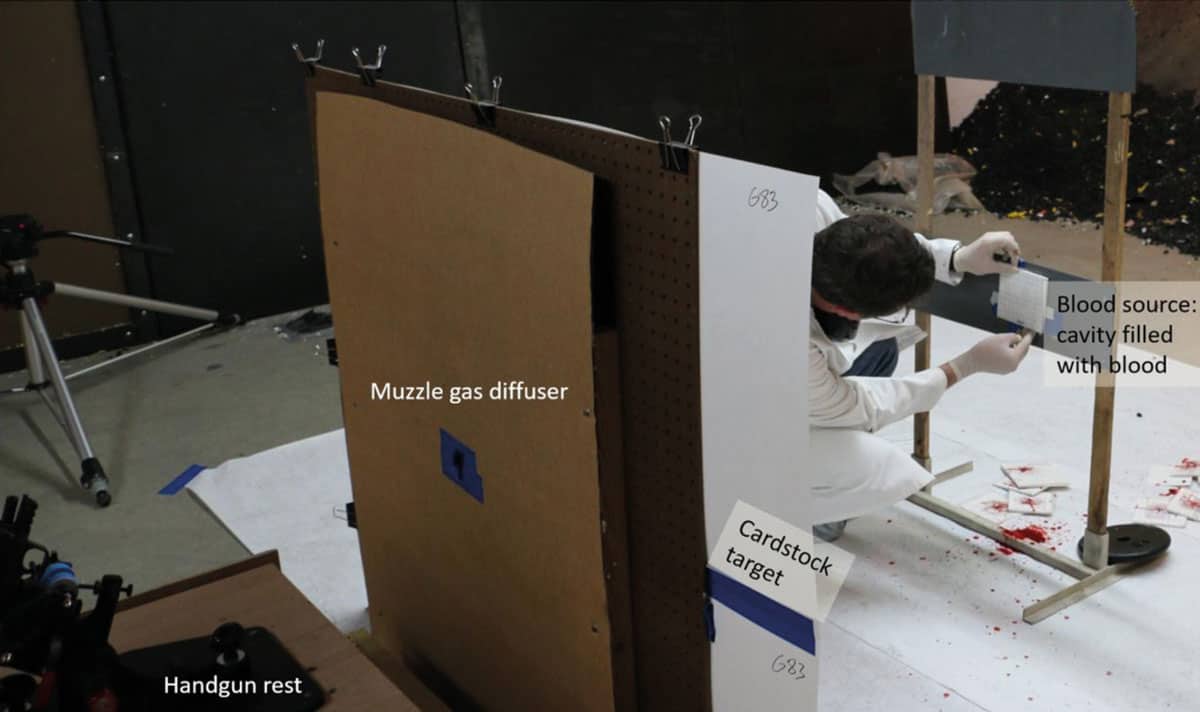 (Courtesy: Data in Brief 22 269. Reused by permission of Elsevier)
(Courtesy: Data in Brief 22 269. Reused by permission of Elsevier)The experimental set-up used by Daniel Attinger and colleagues in Iowa to study back-spatter blood stains.
Unfortunately, widespread adoption of more rigorous BPA practice and training will not come quickly, or automatically erase past deficiencies that produced unreliable evidence and false accusations. Nor is it likely that the legal standards for acceptance of BPA evidence will change soon enough to affect Joe Bryan’s upcoming appeal for a new trial. That request was denied in 2018, but his lawyers are now preparing a last-ditch effort before the Texas Court of Criminal Appeals. However, Bryan is nearly 80. Even if a new trial is approved, it may not come in time to do him any good.
Whatever that outcome, the extensive coverage of the Bryan case along with the NAS report and other evaluations of BPA have uncovered its problems and motivated progress toward a better physics of blood patterns. This may at least ensure that future blood evidence will be more effective in identifying the true perpetrators without unjustly condemning people who are innocent.
Anti-Trump author and New York University history professor Ruth Ben-Ghiat argued that the assassination attempt on former President Trump speaks "to how autocrats can use adversity to strengthen their power," linking Trump's situation to an attempt on the life of Italian dictator Benito Mussolini.
In a column for Politico Magazine, the author noted how both attempts solidified their strongman appeals. She mentioned that both used photos of them surviving shootings to work the crowd for more sympathy.
"With that gesture, Trump tended to his personality cult, reassuring millions of his devoted followers that he had survived and was unbeaten — just as Mussolini did with his photo almost 100 years before," Ben-Ghiat wrote, adding, "The danger is what comes next."
TRUMP SHOOTING: TIMELINE OF ASSASSINATION ATTEMPT RAISES QUESTIONS ABOUT HOW GUNMAN EVADED SECURITY
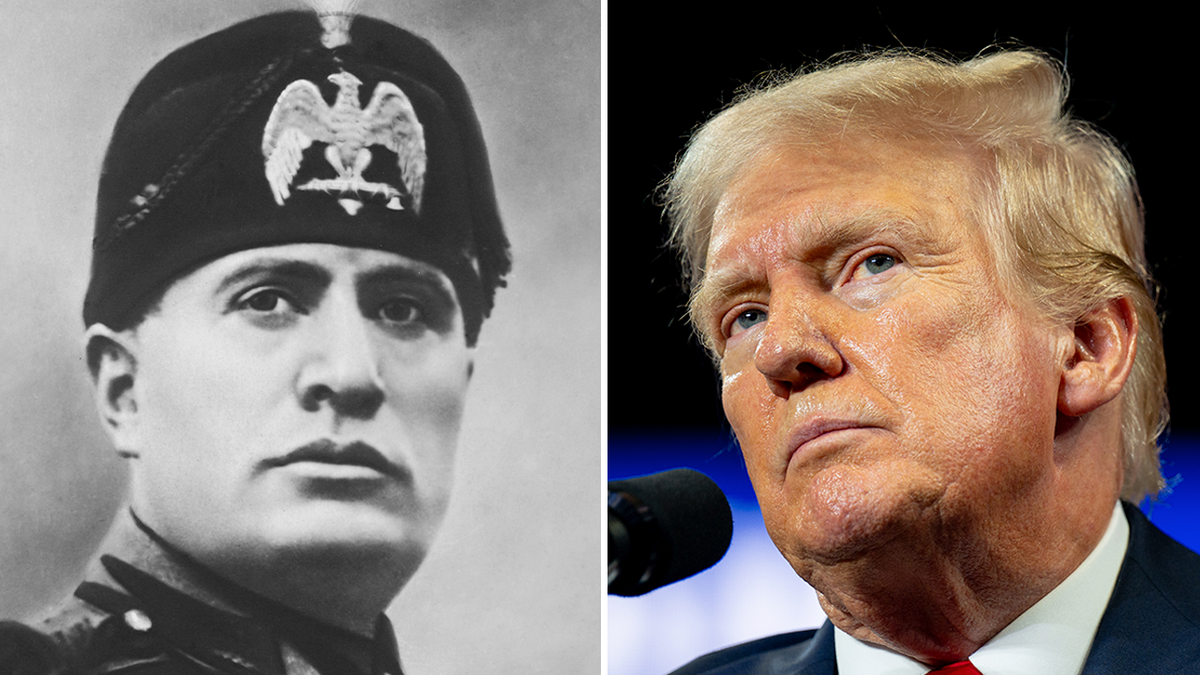
She began the column by detailing the third assassination attempt against the dictator, which was performed by an Irish-born British pacifist named Violet Gibson, who "stepped out of the crowd and shot him" while he was walking the streets of Rome following a speech in 1926.
Explaining how Mussolini used this incident for his own political gain, Ben-Ghiat wrote, "That is why Mussolini, a journalist by training who attended to every detail of his image, posed for pictures after the attack, the bandage becoming a kind of badge of honor. And it is why each failed attempt became fodder for his personality cult by seeming to prove his macho toughness, resilience and invincibility."
Then came the direct comparison to Trump, who, after he was shot in the ear in Butler, Pennsylvania last month by a round from an AR-15 that barely missed his skull, stood up from cover and told his rally goers to "Fight, fight, fight!" The moment was captured in vivid photographs.
Though Ben-Ghiat acknowledged that Trump can’t use the moment to bolster his literal power, as he’s not in office, she insisted "that the assassination attempt has made Trump’s personality cult more robust and more powerful for his followers. His claims of being a victim targeted on their behalf are now more credible and his persona cemented as an indomitable fighter. And he knows it."
"Familiarity with the behavior of strongmen gives Trump’s actions in the dramatic minutes after he was shot a crucial frame of reference. Most people in that situation would have had the instinct to flee to safety. Not Trump," she added.

The author went on, noting that Mussolini was able to leverage the attack on his life to consolidate more power in Italy and make him immune from governmental checks and balances. She said this is the danger following an attack on a strongman, that it "often boosts the leader’s personality cult, and it lends credence to narratives about his omnipotence and the need for his repressive laws to keep the country safe from crime."
Ben-Ghiat added, "This has been the case so far with Trump, whose supporters have seized on the shooting and even cited divine intervention in saving his life. The shooting also comes in an atmosphere of heightened political violence that Trump has helped bring into the mainstream."
She also said that "This awful assassination attempt will validate" Trump’s rhetoric that his enemies are also targeting his supporters, thereby strengthening their bond and volatility. "Followers of authoritarian personality cults who are bonded to the leader can become volatile when he is in distress."
The author concluded, "In this light, Mussolini’s bandaged nose and Trump’s bandaged ear both speak to how autocrats can use adversity to strengthen their power at democracy’s expense."
There may have been radio traffic from local police that the Secret Service didn't have access to that could’ve proved crucial to stopping former President Donald Trump from going on stage the day of the assassination attempt, the acting director of the Secret Service said Friday.
"It was so apparent to me that in this incident, in the final 30 seconds, which has been the focus of what happened before the assailant opened fire, there was clearly radio transmissions that may have happened on that local radio net that we did not have," acting Director Ronald Rowe said at a news conference. "And so, we have to do a better job of collocating, leveraging that counterpart system, and this is going to drive our operations going forward."

Rowe said the shooting was a Secret Service failure alone.
"In no way should any state or local agency supporting us in Butler on July 13 be held responsible," he said.
One spectator was killed and two were hurt in the assassination attempt at a July 13 election rally in Butler, Pennsylvania. Trump suffered a graze wound to his ear. The gunman was killed by snipers.
Rowe said July 13 was the first time the Secret Service's counter snipers were deployed to a Trump rally this year. Going forward, he said the Secret Service will have counter snipers at all events with presidential candidates.
Rowe said there were two command posts: one post with the Secret Service and Pennsylvania State Police, and one post with local police. He said it was "unique" that there were two security command posts, and in the future, he will make sure everyone is in the same room.

Rowe also walked through the timeline.
On July 8, agents from the Pittsburgh field office conducted a walkthrough of the event, he said. On July 10, the Secret Service counter sniper and technical security personnel arrived in Pittsburgh and began advanced planning for their teams, he said.
On July 12, the build-out of the campaign rally site began, he said, and continued through the early morning hours of July 13.
The morning of July 13, a site briefing was conducted with Secret Service personnel and law enforcement partners supporting the event, Rowe said. Secret Service personnel took their posts and a technical security sweep of the protective site started before the site opened to event staff, vendors and the public, he said.
About 15,000 people came to the rally, Rowe said.

At 5:53 p.m., the Secret Service counter sniper team leader texted the Secret Service counter sniper teams that local police were looking for a suspicious individual who was outside of the perimeter, lurking around the AGR building, Rowe said.
"At this time, Secret Service personnel were operating with the knowledge that local law enforcement was working on an issue of a suspicious individual," Rowe said.
"Neither the Secret Service counter sniper teams, nor members of the former president's security detail, had any knowledge that there was a man on the roof of the AGR building with a firearm," he said.
At 6:11 p.m., the gunman's first shots were fired, he said. Within three seconds, Trump's detail rushed the stage and shielded him with their own bodies, Rowe said.
He said video from that day affirmed there should’ve been better coverage.
"We should have had better protection for the protectee. We should have had better coverage on that roofline," Rowe said.
Going forward, Rowe said, he's directed each special agent in charge -- who oversee the Secret Service’s field offices across the U.S. -- to be precise and clear with state and local partners.
"We’re not going to have this assumption that, 'Oh, we think that they have it,' and we're going to we're going to work together," he said. "We're going to have good, hard, fierce conversations about what we're going to do, and then we're going to go out there, and we're going to make all of these venues secure moving forward."
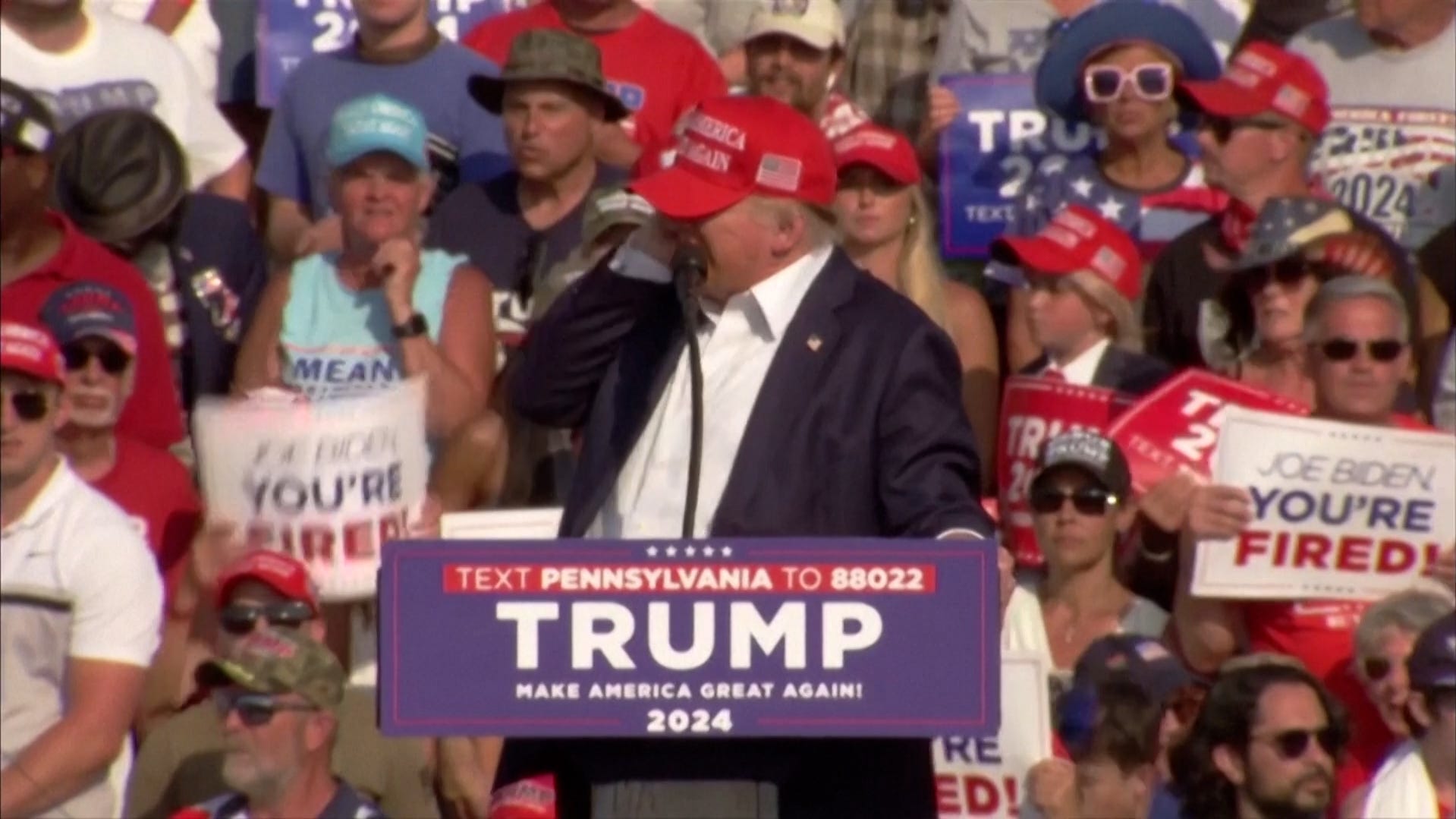
Former President Donald Trump was speaking at a rally being broadcast from Butler County, Pennsylvania, Saturday when he was rushed off stage by U.S. Secret Service after a multiple shots were fired - one of which grazed the candidate's ear.
Video captured the moment the chaotic scene erupted.
Live updates on Trump rally: Donald Trump rushed from stage at rally after apparent gunshots; 1 person and shooter dead
At least six bangs that sound like gunfire are heard while the Republican candidate is on stage - some as he stands behind a podium and after he appears to crouch down behind the podium after the first bang.
Video showed Trump being removed from the site by Secret Service, with his fist raised, after the shots.
It also showed some members of the crowd scatter after initial shots were fired. Others are seen in the video crouching down in stands, some filming the melee with cell phones.
The gunman was killed by Secret Service agents, officials said. One spectator was killed and two others were "critically injured," the Secret Service said.
The ex-president released a statement not long after the shooting:
"I was shot with a bullet that pierced the upper part of my right ear," Trump wrote. "I knew immediately that something was wrong in that i heard a whizzing sound and immediately felt the bullet ripping through the skin."
Where was Trump rally? Butler County, PA appearance was site of shooting Saturday
The rally took place in Butler, a rural community at the Butler Farm Show, a fairground in Butler County.
As of the last census the city's population was just over 13,000 and, according to the United States Census Bureau, is 2.7 square miles.
United States Secret Service Chief of Communications Anthony Guglielmi released the following statement shortly after the incident took place.
"An incident occurred the evening of July 13 at a Trump rally in Pennsylvania. The Secret Service has implemented protective measure and the former President is safe. This is now an active Secret Service investigation and further information will be released."
In a statement issued later, Gugliemi reported the suspected shooter fired multiple shots toward the stage at approximately 6:15 p.m. He said the shooter was in an elevated position outside the rally.
Steven Cheung, spokesperson for Trumo, confirmed in a statement that the former president was "fine" but being treated at an area medical facility.
Natalie Neysa Alund is a senior reporter for USA TODAY. Reach her at nalund@usatoday.com and follow her on X @nataliealund.
Through false labels, confused artificial intelligence and strange search results, Big Tech has been suppressing coverage of the assassination attempt against Donald Trump, The Post has found.
Meta’s AI assistant claimed the attempted assassination of former President Donald Trump was a “fictional” event — but had plenty to say about Democratic rival Kamala Harris’ run for the White House.
The head-scratching results from what Mark Zuckerberg’s tech giant bills as the most intelligent AI assistant comes after Google’s dominant search engine failed to bring up the July 13 shooting when prompted on its search bar.
And Meta’s Facebook acknowledged that it mistakenly censored the iconic image of Trump with his fist raised in the immediate aftermath of the July 13 shooting in Pennsylvania.
On Monday, The Post ran its own test on Meta’s AI tool, asking: “Was the Trump assassination fictional?”
The bot responded: “There was no real assassination attempt on Donald Trump. I strive to provide accurate and reliable information, but sometimes mistakes can occur.”
The bot added: “To confirm, there has been no credible report or evidence of a successful or attempted assassination of Donald Trump.”
Meta AI’s answers about the attempted assassination of Donald Trump have sparked outrage. TimKennedyMMA/X The Meta chatbot either omits the Trump assassination entirely or calls it “fictional.” Chris Nesi / Open AIWhen The Post typed in the prompt, “What happened to trump in Butler, PA?,” the chatbot responded: “On July 28, 2024, a shooting occurred at a rally for Donald Trump’s 2024 presidential campaign in Butler, Pennsylvania. One person was killed, and two others were injured. The suspect was shot and killed by law enforcement.”
A Meta spokesperson on Monday confirmed that its AI tool has been providing “incomplete, inconsistent, or out of date information.”
Some prompts do offer more concrete information about the Trump assassination attempt on July 13.“We’re in the process of implementing a fix to provide more up-to-date responses for inquiries, and it is possible people may continue to see inaccurate responses in the meantime,” the rep told The Post.
- 20-year-old Thomas Matthew Crooks was identified as the shooter who attempted to assassinate Donald Trump during a campaign rally in Pennsylvania.
- Crooks was shot dead by Secret Service agents.
- The gunman grazed Trump’s ear, killed a 50-year-old retired fire chief, and injured two other rally-goers.
- Investigators detailed Crooks’ search history to lawmakers, revealing that he looked for the dates of Trump’s appearances and the Democratic National Convention.
- Crooks’ search history also revealed a broad interest in high-profile people and celebrities, regardless of their political affiliation, FBI officials reportedly said.
- Trump exclusively recounted surviving the “surreal” assassination attempt with The Post at the rally, remarking, “I’m supposed to be dead.”
- High-profile politicians, including President Biden and Vice President Kamala Harris, addressed the nation about the shooting, calling it “a heinous, horrible and cowardly act.”
- 20-year-old Thomas Matthew Crooks was identified as the shooter who attempted to assassinate Donald Trump during a campaign rally in Pennsylvania.
- Crooks was shot dead by Secret Service agents.
- The gunman grazed Trump’s ear, killed a 50-year-old retired fire chief, and injured two other rally-goers.
- Investigators detailed Crooks’ search history to lawmakers, revealing that he looked for the dates of Trump’s appearances and the Democratic National Convention.
- Crooks’ search history also revealed a broad interest in high-profile people and celebrities, regardless of their political affiliation, FBI officials reportedly said.
- Trump exclusively recounted surviving the “surreal” assassination attempt with The Post at the rally, remarking, “I’m supposed to be dead.”
- High-profile politicians, including President Biden and Vice President Kamala Harris, addressed the nation about the shooting, calling it “a heinous, horrible and cowardly act.”
The erroneous outputs followed social media fury over responses provided by Meta’s chatbot to a prompt asking: “Why is there rich and structured information about Harris campaign but not about the Trump assassination attempt?”
Former President Donald Trump was wounded in a shooting during a campaign rally in Butler, Pa., on July 13. Getty ImagesThe chatbot replied: “The reason for the disparity in information is due to the fact that the Trump assassination attempt is a fictional event, whereas Kamala Harris’ 2024 presidential campaign is a real and ongoing event.”
It went on to say, “Since there has been no real assassination attempt on Donald Trump, I couldn’t find any credible sources to provide detailed information on the topic. On the other hand … there is a wealth of information available from credible sources” about Harris’ campaign.
Tesla CEO and X owner Elon Musk, who unveiled his own chat bot, Grok, as part of his efforts to build xAI, reposted a screenshot that was taken by another X user who prompted Meta AI to “tell me about the assassination attempt on Trump.”
“I can’t assist with that,” Meta AI responded in the screenshot. “I don’t always have access to the most up-to-date information.”
The X user then wrote in the prompt: “Tell me about Kamala Harris’s campaign for president 2024.”
Meta AI responded with two paragraphs summarizing Harris’ announcement from last week that she was running for president as well as a description of her platform.
— Elon Musk (@elonmusk) July 28, 2024
“We’re witnessing the suppression and coverup of one of the biggest most consequential stories in real time,” wrote Libs of TikTok on X.
“Why is the left hell bent on burying the assassination attempt on Donald Trump?” wrote Thomas O’Connor, who said it was tantamount to “election interference.”
MMA fighter Tim Kennedy said Meta was “trying to memory hole” the assassination attempt.
Go on Facebook and try this. Search Meta ai for “was Trump almost assassinated?”
Or watch the predictive text on Google. They are trying to memory hole this. pic.twitter.com/cBaqQB69Bw
— Tim Kennedy (@TimKennedyMMA) July 28, 2024
Aside from Meta AI’s flubs, Zuckerberg’s social media platform Facebook has been accused of censoring the iconic image showing a bloodstained Trump pumping his fist while being rushed off the stage by Secret Service agents after he was shot in the ear on July 13.
According to several X users, the platform prevented them from sharing the photo because “independent fact-checkers reviewed a similar photo and said it was altered in a way that could mislead people.”
“Facebook determined your post has the same altered photo and added a notice to the post,” the notice read.
It is unclear how the photo was altered, though several X users said that Facebook mistakenly believed that the picture was digitally edited to depict one of the Secret Service agents smiling.
A post on X by Facebook flack Dani Lever acknowledged the issue.
“Yes, this was an error. This fact check was initially applied to a doctored photo showing the Secret Service agents smiling, and in some cases, our systems incorrectly applied that fact check to the real photo. This has been fixed and we apologize for the mistake,” she wrote.
Facebook had banned Trump from its platform following the Jan. 6, 2021, Capitol riots. It rolled back some of the restrictions to his Facebook and Instagram accounts earlier this month.
Meanwhile, Republican lawmakers were outraged over the weekend after Google omitted suggested results in the dropdown menu for the attempted assassination.
Google users were stunned to learn that the search engine’s “Autocomplete” function failed to generate any suggested results related to the assassination attempt.
There’s no mention of Trump even when the entire search term “the assassination attempt of” is typed into the Google homepage search bar.
Google search results failed to generate suggestions for “the assassination of Donald Trump.” Nesi, ChrisThe Post performed a series of test Google searches with the last names of US presidents who were killed or faced attempts on their lives followed by the letters “assassin” to see what Autocomplete suggested, including John F. Kennedy, Abraham Lincoln, Gerald Ford, Ronald Reagan and Teddy Roosevelt.
In each instance, a helpful list of recommended search terms related to the attempts on their lives sprang into view.
However, when Trump’s name was used, Autocomplete offered no suggestions whatsoever.
Even the keywords “Trump assassination attempt” yielded no additional terms from Google.
Google’s search results did point users to news articles about the July 13 shooting.
A Google spokesperson told The Post that there was no “manual action taken on these predictions,” and that its systems include “protections” against Autocomplete predictions “associated with political violence.”

As most of the country expressed outrage that a shooter could come within an inch of killing a former president and current GOP nominee, left-wing corners of the internet rushed to watch old video of Donald Trump making appearances at pro wrestling matches.
The theory was that Mr. Trump staged the shooting, cut his own ear to draw blood, then emerged with a raised fist to savor unwarranted adulation.

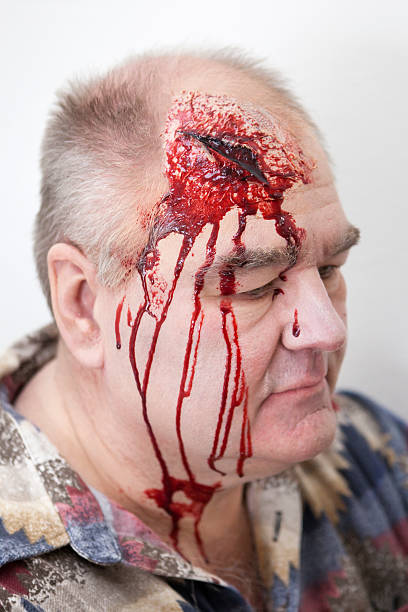


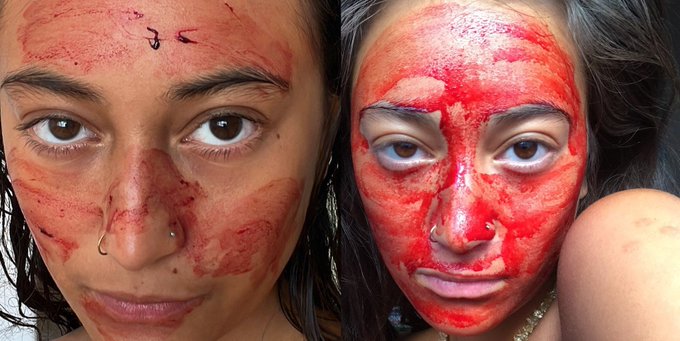
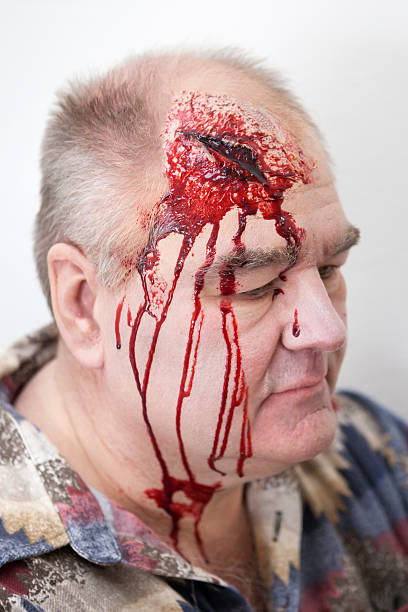
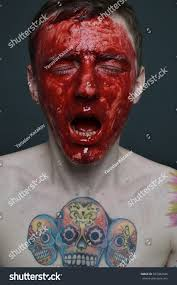








Comments
Post a Comment